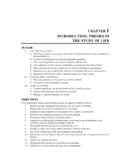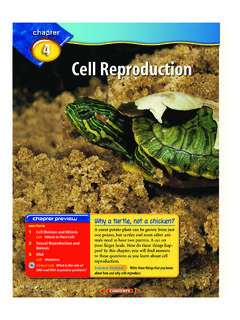Transcription of Chapter 8 Notes: Social Relations Behavioral ecology ...
1 Chapter 8 Notes: Social Relations Behavioral ecology : relationships between organisms and environments that are mediated by behavior. Sociobiology: branch of biology concerned with study of Social Relations . Evolutionary fitness: number of offspring (genes) contributed to future generations. Fitness can be substantially influenced by Social Relations within a population. Q: Biologically, what defines male and female? Females usually produce fewer, larger, and more expensive gametes. Males usually produce more, smaller, less expensive gametes. Thus, female reproduction is generally limited by access to necessary resources, while Male reproduction is limited by access to reproductive females, leading to the dichotomy of actively courting males and highly selective females.
2 Hermaphrodites: individuals who combine both male and female functions into one individual. (fig ) Consider perfect flowers, for example. Mate Choice vs. Predations The effects of female mate choice on the evolution of ornamentation in males can be reduced by other sources of natural selection. Sexual selection: results from differences in reproductive rates among individuals as a result of differences in their mating success. Intrasexual selection: individuals of one sex compete among themselves for mates. Intersexual selection: members of one sex (usually female) consistently choose mates from among members of the opposite sex on the basis of a particular trait. Sexual selection will favor elaboration of the trait.
3 (fig ). Darwin proposed sexual selection will continue to elaborate a trait until balanced by other sources of natural selection, such as predation. In Guppies In many habitats, adult guppies are preyed on by several species of carnivorous fish. Male guppies show a broad ranged of coloration. Female guppies, if given a choice, will mate with more brightly colored and behaviorally dominant males. The characteristics reflect the male's health and access to food, which is passed down, will increase the female's inclusive fitness. BUT, these characteristics are also risky. Most brightly colored males are found in lower preyed upon populations, indicating coloration is also affected by predation. Page 1 of 9. Why did John Endler take great care to put all the same colors of gravel in the same proportions into all of the greenhouse ponds?
4 In Endler's field experiment, why did male colorfulness increase in the absence of effective predators and not just remain unchanged? What do female guppies potentially gain by mating with colorful males? Concept Review Answers 1. The influence of prey color on vulnerability to predators is strongly influenced by the background against which the predator views the prey. 2. The observed increase in colorfulness among male guppies in the absence of effective predators suggests that colorful males have some selective advantage, probably related to how female guppies choose their mates. 3. One advantage to females mating with colorful males is that it increases the chances of their giving birth to colorful sons who will be attractive to prospective mates.
5 : Mate Choice and Resource Provisioning Females of some species select mates based on male's ability to provide resources. Thornhill's scorpionflies . Flies feed on dead crickets on the forest floor. Since supply is limited, competition is intense, especially intersexual by males. When a male fly secures a food item, he secretes a pheromone, attracting females. Without a food item, they will secrete a saliva mass. Thirdly, forced copulation Q. Is there a difference in mating success among males using different strategies? Experiment males competed for different sized crickets. Some males won, some offered saliva, some had none A. males with a medium or large cricket had a clear advantage over small or no crickets.
6 What here is the potential benefit to the females? What are they selecting for and why? 1. Females do not have to engage in risky foraging behavior. 2. Nutritional benefit allwo0s females to lay more eggs. 3. If ability to provide food is controlled genetically (and is thus a heritable trait), it can increase a female's inclusive fitness Q. What factors determine whether males compete successfully for food offerings or resort to less desirable alternatives? Experiment males competed for crickets, some won, some offered saliva. Winners were removed, losers thieved the crickets. Battles can be dangerous damaging to limbs and wing parts. Male body size varies Q: Do larger males compete more successfully for crickets?
7 Page 2 of 9. Experiment small, medium, large males, crickets, and females were maintained at natural densities for one week. A. most small males had no crickets, medium offered saliva, and large often offered crickets. Large males got 60% of matings. CR What evidence is there that the availability of dead insects for scorpionfly feeding is limited What led Thornhill to conclude that mating success by male scorpionflies is tied to the quality of nuptial offerings presented by males? CR Which results clearly show the influence of intrasexual selection on male scorpionfly mating success? Concept Review Answers 1. Male scorpionflies fight over dead arthropods and even steal arthropods from spider webs where they may be trapped.
8 2. Males guarding large and medium sized dead insects have greater mating success than males guarding small dead insects or salivary masses. 3. The largest male scorpionflies, and presumably the best at defending resources, are able to maintain possession of the highest quality nuptial offerings. Nonrandom mating in plants Mating in wild plants can be non random. (Consider why this should be ). a. maternal control over fertilization b. competition among pollen c. some combination Diane Marshall Pollen donors vary widely in performance CR What roles did greenhouse and field studies play in the investigation of mating patterns by wild radish? CR What would you expect to see in figure if performance were equal across pollen donors?
9 Concept Review Answers 1. The greenhouse environment allowed the researchers to keep environmental conditions constant for all plants, which meant they could isolate the influences of male pollen donor on mating success. Meanwhile, the field conditions provided evidence that nonrandom mating occurs even where maternal plants are exposed very different environmental conditions. 2. If performance were equal, the heights of the bars would be approximately equal for all pollen donors. An expectation of no difference is called a null hypothesis.. Sociality Sociality is driven by the need for group defense of high quality territories and/or defense of mates and young. Page 3 of 9. Cooperation exchanges of resources between individuals or various forms of assistance, such as defense against predators.
10 Cooperation + group living = sociality Eusociality complex level of Social behavior, pinnacle of Social evolution, societies 1. more than on generation living together 2. cooperative care of young 3. division into reproductive status castes Apparent restriction of reproductive opportunities that comes with sociality would challenge the idea that the fitness of an individual is determined by the number of offspring it produces, because some individuals not only do not reproduce, but actually help others to do so. Because this behavior persists, we have to assume that benefits of society must outweigh the costs. Cooperative breeders Some individuals function as helpers defense, construction, childcare, etc. WHY?








